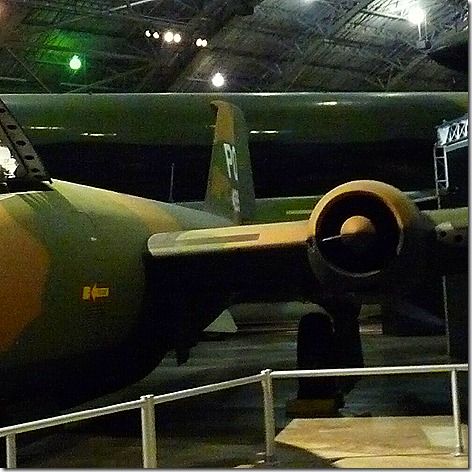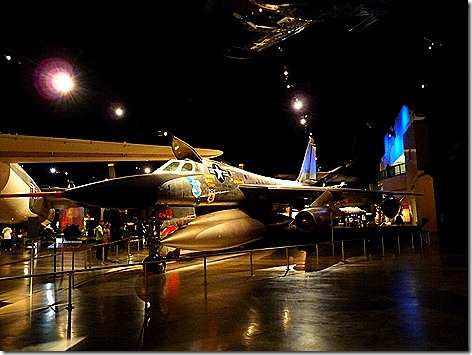Daily Archives: July 16, 2018
Wright-Patterson Redux . . .
Again, a slow day both at work and at home, so following up on last week’s repost of our visit to the Evergreen Aviation Museum and the ‘Spruce Goose’, here’s a repost power of our visit with our friend’s Nick and Terry Russell to The National Museum of the United States Air Force.
September 22, 2012
We headed out on our Dayton daytrip about 9:30, but our first stop was at the McDonald’s in Harrison, right inside the Ohio line. And after a quick breakfast we were back on the road for the rest of our 85 mile trip.
Our first stop was the Dayton Aviation Heritage National Historical Park, located in and around buildings that housed the Wright Brothers and their businesses.
Most people know about their bicycle shop, but less well-known is the fact they were also in the printing business, printing newspapers, flyers, pamphlets, and other items. And in addition to running two companies, they were also designing the first airplane at the same time.
As their businesses expanded, they moved to bigger buildings but always in this same small area of Dayton.
One of the first things you see inside the Museum is a replica of the Wright’s 1902 Flyer, the first successful powered heavier-than-air craft.
dasdfsdf
While we were there we also saw this replica of the Wright’s Bicycle Shop, where they repaired bicycles and built new ones.
Although Jan and I enjoyed here, we both agreed that we liked the Wright Brother’s museum at Kitty Hawk, NC better.
Next we headed about 10 miles away to visit The National Museum of the United States Air Force at Wright-Patterson Air Force Base

Like visiting the Smithsonian Air and Space Museum, it’s hard to know where to start here. They had pretty much one of everything, including some that I’ve never seen in person before.
There are planes everywhere you look, in front, behind, overhead, etc.
dasdfsdf
From the Red Baron’s Fokker Triplane,
dasdfsdf
to the Kettering ‘Bug’, essentially a 1917 version of the cruise missile.
dasdfsdf
And this Kellett K3 Autogyro.
dasdfsdf
This is the last remaining Seversky P-35, the forerunner to the P-47. It was the Army Air Corps first production, singe-seat, all-metal pursuit plane with retractable landing gear and an enclosed cockpit.
It also has the unique property of being the only plane flown by both the U.S. and the Japanese during World War II. The Japanese government bought 20 of these from the US in 1938 and used them through the war.
dasdfsdf
I can only figure that the pilot of this B-24 Liberator either married a redhead, or got a ‘Dear John’ letter from one.
dasdfsdf
This is the ME 163B Komet, a WWII German rocket-powered interceptor designed to climb rapidly and bring down the Allied bomber formations. It was hampered by its short range and vulnerability to being shot down while landing.
dasdfsdf
The is the ME 262A, the first jet aircraft used in combat.
dasdfsdf
This is the P-61C Black Widow night fighter, the first US plane designed specially for that purpose. The radar in its nose allowed to track and shoot down enemy aircraft in total darkness.
dasdfsdf
This is one that I’ve never seen in person before. It’s the F-82G Twin Mustang, similar to the P-38 Lightning, in that it has two fuselages joined by a common wing. It was the last propeller-driven fighter aircraft acquired by US.
dasdfsdf
And this is the B-29 ‘Bockscar’, only the second plane to drop an atomic bomb in wartime, in this case, on Nagasaki, Japan.
dasdfsdf
And this is a replica of the ‘Fat Man’ bomb that was dropped. It derives its explosive power from the plutonium, unlike the ‘Little Boy’ bomb that was dropped on Hiroshima three days earlier, that was powered by Uranium 235.
dasdfsdf
With the ‘Enola Gay’ we saw at the Smithsonian in Washington, D.C. in 2009, and the ‘Bockscar’ today, we’ve now seen both WWII atomic bombers. Neat!
The next aircraft on the tour was the Convair B-36.
The B-36 was the largest mass-produced piston engine aircraft ever made and had the longest wingspan of any combat aircraft ever built. It was also the only combat aircraft propelled by both piston and jet engines.
dasdfsdf
The B-36 was slow and could not refuel in midair, but could stay aloft as long as 40 hours. It was so big it even had 6 bunks and a crew dining area.
Moreover, its phenomenal cruising altitude for a piston-driven aircraft, 50,000 ft. put it out of range of all piston fighters, early jet interceptors, and ground fire.
The photo below shows the relative size of the WWII B-29 and the B-36.
It was operational from 1949 to 1959 when it was finally replaced by the B-52, which debuted in 1955.
This is the A-7D Corsair II ground attack plane. I used to work on these when I was a DOD contractor.
dasdfsdf
And this is the A-37D Dragonfly. Built by Cessna (yes, Cessna) it was originally the T-37 light trainer, but was outfitted as a combat aircraft during the Vietnam War. Another aircraft I worked on.
dasdfsdf
This is the Canberra B-57B light bomber. I worked on these at Otis AFB on Cape Cod during the early 70’s, although I was working on the RB-57 reconnaissance versions and the EB-57 electronic countermeasures version.
dasdfsdf
The Canberra was actually a British design built under license by the US. Designed at the end of WWII it was originally slated to have piston- driven prop engines which accounts for the mid-wing nacelles. But it was switched over to jets before it went operational.
It’s also the only plane I ever worked on that had Buick (yes, Buick!) jet engines. Until I saw these, I never even knew Buick made jet engines.
dasdfsdf
This is the B-58A Hustler, the first US jet bomber to cruise at supersonic speeds, in this case, over 1300 mph.
dasdfsdf
The B-2 Stealth Bomber.
dasdfsdf
This is the fabled U-2 spy plane, 
dasdfsdf
which was replaced by the SR-71 Blackbird spy plane.
The SR-71 still holds the records for both altitude (over 85,000 ft.) and speed (almost 2200 mph) for an air-breathing engine (i.e. not a rocket). It is however, rumored that the Blackbird was easily capable of exceeding these public records when needed.
I got to work on one these one time when I was at Otis AFB.
dasdfsdf
The museum also had a great collection of missiles and rockets, from the Jupiter to the Minuteman, and more.
dasdfsdf
If you like planes, this is a museum for you. Check it out.
dasdfsdf
Tomorrow we’ll be back over at the house, with side trips to Home Depot and Lowe’s checking out what we want to do at the house.
Thought for the Day:
You have enemies? Good. That means you’ve stood up for something, sometime in your life.
dasdfsdf



































